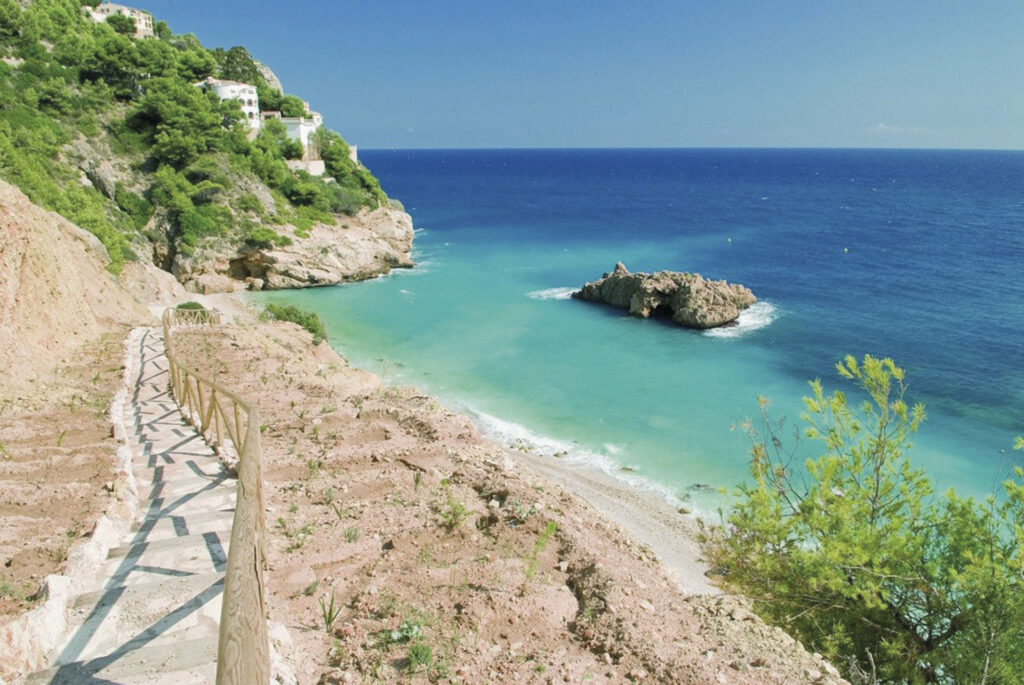The jewel in the coast of Jávea is the cove known as Granadella. Two years after a dreadful fire, the environment is regaining life and green colour predominates little by little.
The coves gather the seductive essence of the coastline, more than any other overview of the sea. In Oliva Nova, we are right next to the best setting of coves in the eastern coast of Spain, some of them considered as the most exclusive coves from the Mediterranean Sea. From Denia to Pilar de la Horadada, the Costa Blanca covers 244 kilometres of beaches and also stunning coves. Distant places with crystal-clear water, wild spots, surrounded by nature. Most of them are beaches with river stones, others with fine white sand; but all of them are hidden under steep cliffs, where sometimes the sea is calm, sometimes rough by the wind. Places where closing your eyes, breathing deeply and wishing that moment lasts forever.

To reach the most impressive coves, you have to walk for a few minutes, go down steep stairways or reach them by sea, but the reward is worth the effort. Priceless pieces of art for instagramers, without a doubt.
Denia is the city that marks the beginning of the area known as Costa Blanca, from north to south, and it is the spot where the stunning Montgó massif sketches the beach area known as Les Rotes, only 20 minutes away from Oliva Nova. It is a long coarse-grained beach, with pebbles and rocks, where the sea flows together with the fresh water that filters through the hillside of the Montgó massif.

Beyond the Montgó, starts the richest area in coves from the Mediterranean Spanish coast. Jávea is the town with the widest range of beaches and coves from the whole province of Alicante. After the village, there are three capes pointing to Ibiza (Cap Prim, Cap Negre and Cabo de La Nao) which draw a rugged coastline, hosting amazing coves in the cliff face. Among them, the cove named as Portitxol stands out on the edge of an astonishing cliff. It looks like a painting, with its little white squared houses with blue doors, in front of the sea, surrounded by vegetation growing on the rocks and almost reaching the sea. On the horizon, there is the Portitxol Island. The cove can be accessed by car from the Cabo de la Nao road or descended on foot from the Mirador de la Cruz del Portitxol, walking along natural paths for about half an hour.
The jewel in the coast of Jávea is the cove known as Granadella. Two years after a dreadful fire, the environment is regaining life and green colour predominates little by little. It has been the setting for some film sequences (the latest being The cold light of day, starring Bruce Willis and Halle Berry). A secret paradise with crystal-clear water, colour contrast and magnificent rocks. On the top, from the Granadella road, there is the possibility of accessing its scenic viewpoint and, from the cove’s parking area, the hiking route to the Granadella Castle, a small fortification built on a hill.
Only two kilometres away and also by the cape known as Cabo de la Nao, the cove known as Ambolo is the furthest virgin cove. A world apart. Up to the point that access by car is restricted. There is a staircase cut out of the rocks to access the beach. It owes its name to the watchtower built in the 16th century, whose function was surveillance and maritime defence from pirate attacks.
After crossing Jávea, the Costa Blanca area presents one of its nicest coves: Cala Moraig. Apart from the beautiful landscape, it is accessible by car arriving almost as far as the beach. Besides, it is a wide cove. The access from Benitatxell, right behind the Puig Llorença massif, flows towards the residential area known as Cumbre del Sol. Once the summit is reached by road, the extraordinary descent towards the cove is exciting. This tiny but exceptional enclave in a landscape of cliffs, pebbly and with turquoise blue water, offers a spectacular landscape. Due to the quality of the seabed, it is a mecca for diving enthusiasts. There it is an aquatic cave-like room known as “Cova dels Arcs”, sculpted by the drainage of a karst system with two stone arches chiselled by the mere action of waves.
Between the towns of Moraira (district of Benissa) and Calpe, there is another delightful stretch of coast. Some of the most attractive coves in the Costa Blanca come and go in just 20 kilometres. No matter if they are sandy, pebbled or with boulders, they all have crystal-clear water which allows seeing the excellent rocky bottoms hidden under it. Els Pinets, a small but fascinating cove, with views to the Peñón de Ifach; L’Andragó, Baladrar, Advocat and Fustera are the four most attractive coves. The coastal road leading to Calpe allows getting to the coves flanking the impressive crag. On the north face, the so-called Cala del Penyal is attractive because of its views and the quality of its deep blue water.
The natural show goes on towards Altea and Benidorm. The cove known as Cala del Tio Ximo, located between steep cliffs, becomes the counterpoint to the vast sandy beaches in Benidorm. Its location between cliffs grants it of a huge beauty, its crystal-clear water and the wonderful rocky seabed turn it into the perfect place for snorkelling. The cove combines pebbles and gravel; however, the sandy floor allows enjoying the swim. Right next to it, lying at the foot of the Sierra Helada, there is the cove known as La Almadrava in a unique natural environment.
Coves of all sizes and colours where the sea goes into the land and draws a round shape.













